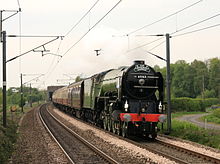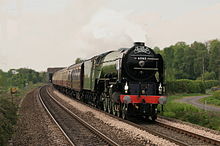- Digital manipulation in railway photography
-
Digital manipulation of railway photographs is the practice of image editing using graphics software to correct flaws or improve the aesthetics of a digital photograph of a train. The ethics of the practice are debated amongst railway enthusiasts, as it allows the creation of images that may appear to be other than their actual subjects. This is most notably by removing modern features, so that an image of a surviving locomotive hauling a modern special is made indistinguishable from a period photograph.
As well as the usual corrections such as cropping or adjusting the brightness or color balance, in order to improve the composition, often more drastic photo manipulation is undertaken. This manipulation can involve the removal of items in the image, or changing the livery (paint scheme) or other identitifying marks of railway vehicles in the image.
Manipulation is common in the photography of steam locomotives. Photographers often remove anachronistic objects from the scene in order to portray a more authentic setting, or change the liveries of engines or coaches to match historically accurate coaches and locomotives, or simply to suit personal preferences. Steam railway photographers will often remove unwanted overhead lines and their pylons, modern lineside equipment or signals. Vehicle liveries are often changed to achieve uniformity for all the coaches in a train (the rake) where dissimilar colour vehicles have been used. In the situations where a railtour operator is able to supply a uniform rake, on longer mainline tours the train will often still include a different colour support coach. Other rakes will contain dissimilar coaches when modern generator cars are required for train heating. When a diesel locomotive has been attached to the train for operational reasons such as assistance on a bank, shunting, or for generation in the heating role, this is also often removed. The locomotive livery may also be changed to simply demonstrate what a locomotive would look like in an alternative, and possibly extinct or never used, livery. Photographers also often compensate for poor weather conditions at the time of the photograph, for example when the wrong wind direction causes the smoke trail from the locomotive chimney to obscure all or part of the train. Livery changes or scene reinstatement for smoke removal is often achieved through the use of short term rephotography, where the photographer takes two images at the same site and overlays one onto the other.
See also
- High dynamic range imaging
- Heritage railway
- Railway photography
- Digital camera
References
- Heritage Railway magazine, Issue 122, March/April 2009
Categories:
Wikimedia Foundation. 2010.


